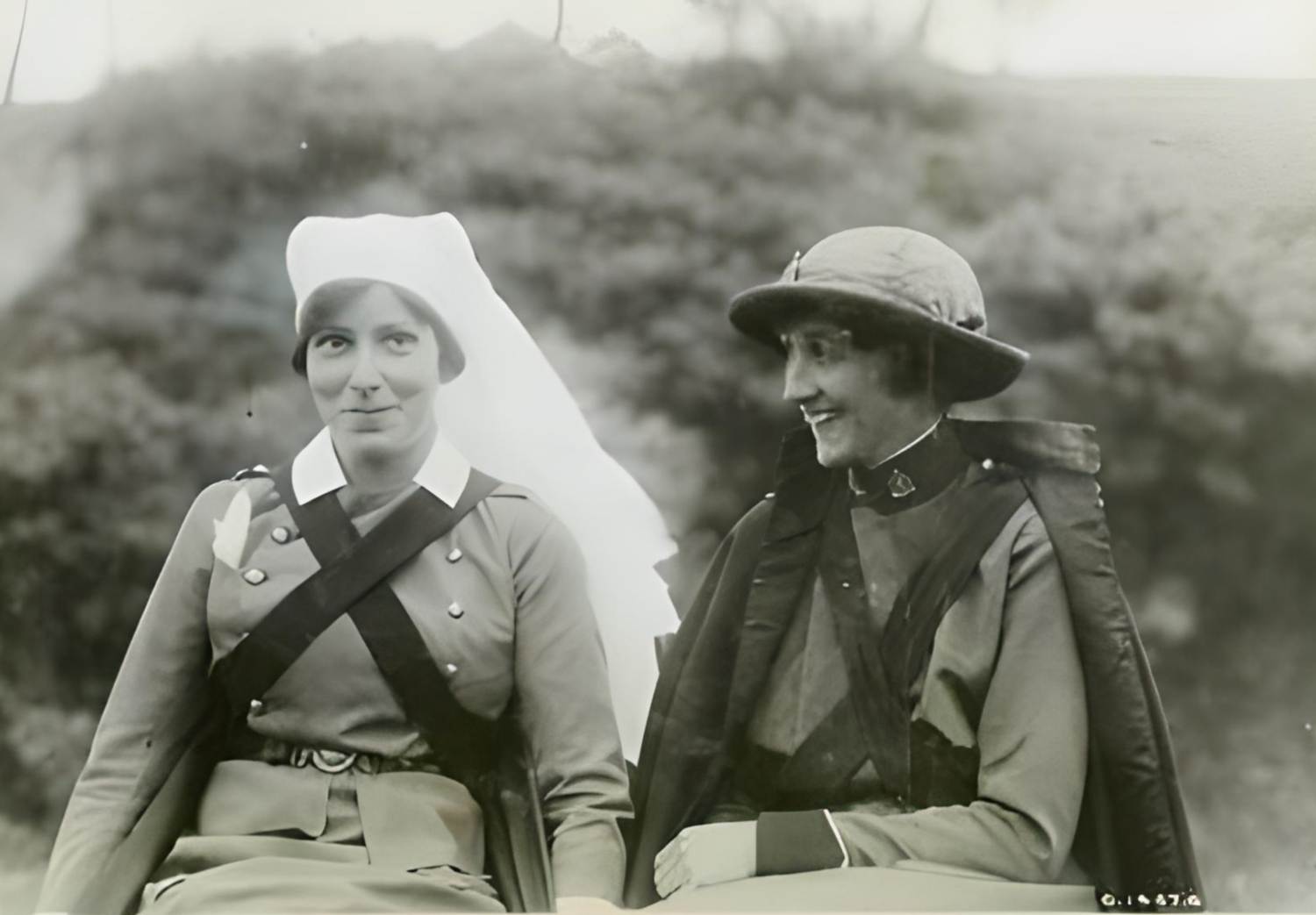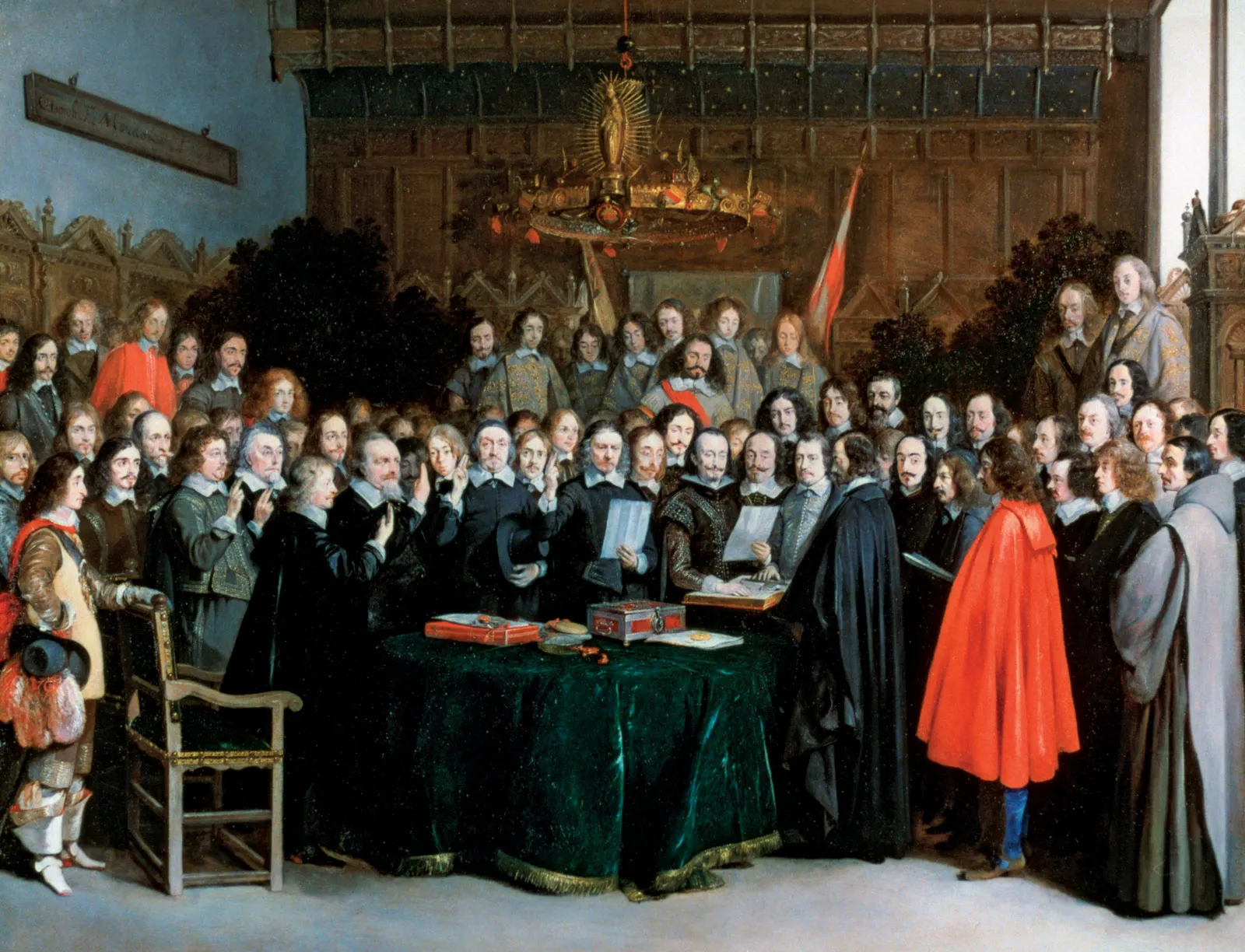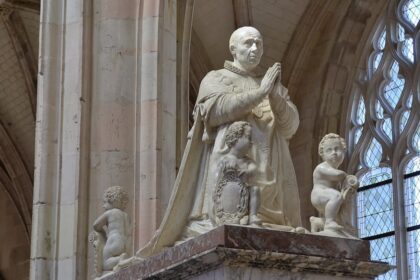The Thirty Years’ War corresponds to a series of religious and political conflicts that unfolded in Europe from May 23, 1618, to October 24, 1648. It witnessed the clash of two factions: the Catholic Habsburgs of Spain and the Holy Roman Empire, and the Protestant princes of the German states within the Holy Roman Empire. Most European nations participated in this war, resulting in significant human casualties, estimated at between 4 and 7 million deaths.
The Peace of Westphalia, signed in October 1648, marks the conclusion of the Thirty Years’ War. Germany officially divided its religious and political powers, with France emerging as a dominant force in European relations, while Spain underwent a perilous decline.
Why Did the Thirty Years’ War Take Place?
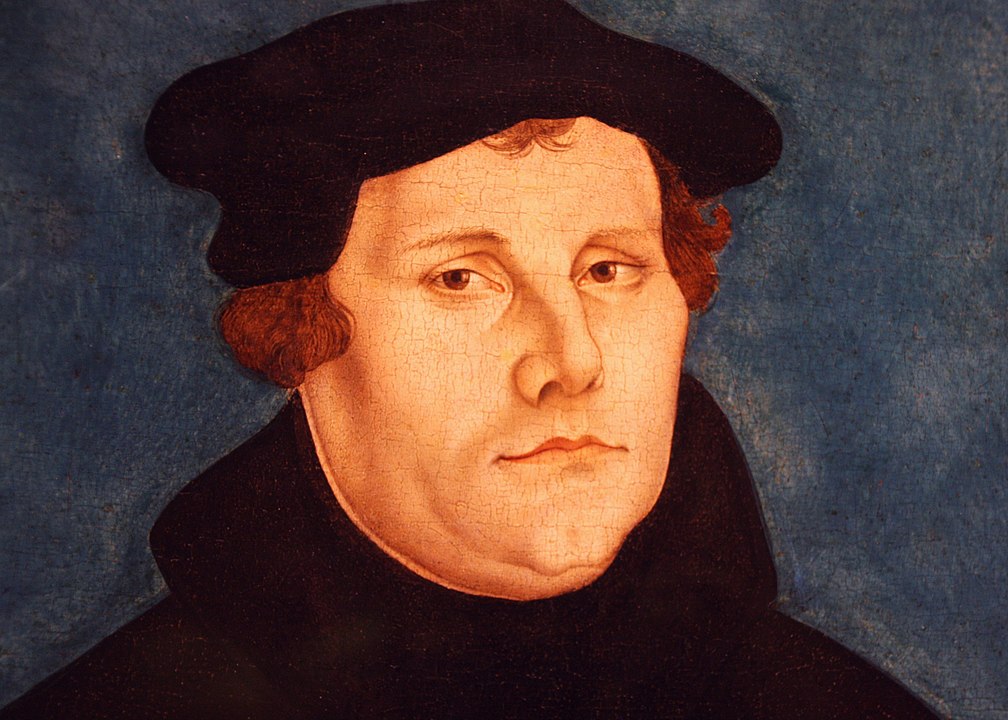
The Protestant Reformation has its origins in the “95 Theses,” drafted by Martin Luther in 1517. Protestantism then spread to Prussia and the Northern countries; Germanic princes converted. In 1555, the signing of the Peace of Augsburg confirmed that two religions could coexist in Germany: Lutherans and Catholics.
The Holy Roman Emperor, Charles V, considered his failure to protect Catholicism and withdrew from political life in 1556. His brother, Ferdinand I, inherited the Empire, and his son inherited the Kingdom of Spain. For years, the ideas of the Reformation and Counter-Reformation spread across Europe.
However, on May 23, 1618, Bohemian Protestants revolted against their new Catholic king. The recently elected king has decided to Catholicize his kingdom, leading to a dispute where representatives of the Catholic empire are thrown out of windows. This event, known as the Defenestration of Prague, marks the beginning of the Thirty Years’ War.
In 1619, Emperor Matthias I died, and his cousin, Ferdinand II, who was also the King of Bohemia, was elected to lead the Holy Roman Empire. Dissatisfied, the Bohemians elect a new king, and the Elector Palatine, Frederick V. Ferdinand II, intervenes to crush the rebellion.
Who Fought in the Thirty Years’ War?
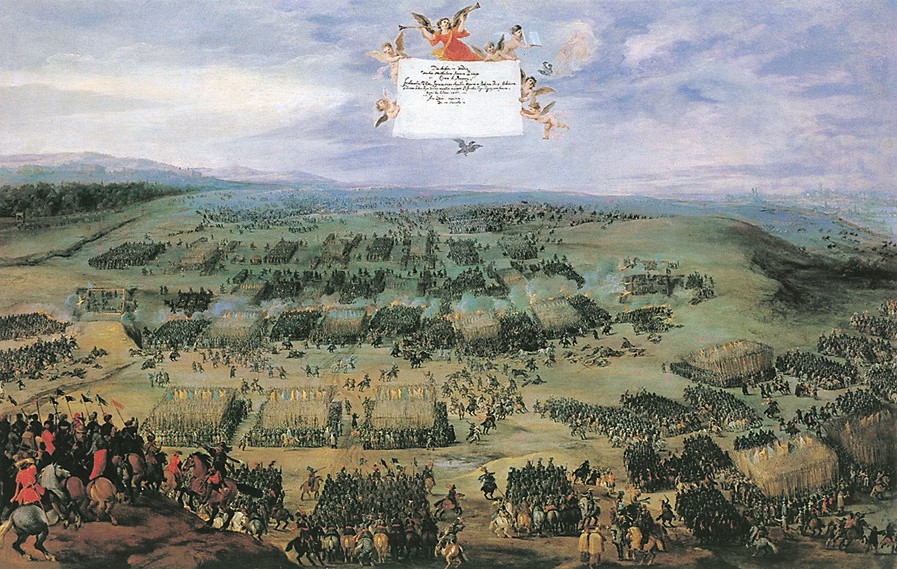
The religious conflict of the Thirty Years’ War began in Germany, stemming from the Bohemian uprising. The Protestant princes of the Evangelical Union (including the Elector Palatine, the Duke of Neuburg, and the Duke of Wurttemberg, among others) rose against the Catholic Holy League (including the Emperor, the Kingdom of Spain, Saxony, Poland, Bavaria, etc.). The Bohemian army was crushed in the Battle of White Mountain on November 8, 1620.
In late 1624, the King of Denmark supported the Protestants, but his army faced defeat, leading to the signing of the Peace of Lübeck in 1629. In the same year, the King of Sweden intervened in solidarity with the Lutherans, but he died in 1632 during the Battle of Lützen.
Emperor Ferdinand II secured the Peace of Prague on May 30, 1635, returning to the status quo of the Peace of Augsburg. Louis XIII‘s France, surrounded by the Habsburgs, saw advantages in weakening the empire. France entered the war in 1635 alongside Sweden, after covert involvement for years.
The Spanish were defeated by Grand Condé in the Battle of Rocroi on May 19, 1643. The war persisted until 1648, concluding with the Battle of Lens, a French victory against the Habsburgs of the Netherlands.
Alsace and Lorraine During the Thirty Years’ War
Alsace and Lorraine were among the regions most severely affected by the Thirty Years’ War. They were devastated by the passage of several armies, including Swedish, Spanish, and French troops.
Confusion is fueled by residents turning to banditry to escape poverty. Different nations employ mercenaries, which are sometimes challenging to control. The price of wheat reaches unprecedented heights, forcing residents to subsist on roots and herbs. Twenty years of famine, epidemics, and exodus have led to a decrease of half or even three-quarters of the population in these regions.
Did Massacres Take Place During the Thirty Years’ War?
The Thirty Years’ War resulted in between 4 and 7 million casualties, comprising both military personnel and civilians. Various armies engaged in atrocities, such as massacres, rapes, and tortures, often driven by a desire for revenge. An illustrative incident is the sack of Magdeburg in 1631, where Catholic League troops brutally killed 25,000 out of the city’s 30,000 inhabitants.
In 1635, the women of a village sought refuge atop a mountain, subsequently choosing suicide upon the approach of Swedish forces, leading to the naming of the mountain in the Vosges as the “Planche des Belles Filles.” Mercenaries, when faced with negligible or non-existent pay, resorted to self-remuneration through the perpetration of similar atrocities.
Aftermath of Thirty Years’ War

After the treaties of Westphalia, signed on October 24, 1648, Germany was the most affected country, and some of its provinces (Saxony, Palatinate, Alsace, Lorraine) lost up to half of their population. It was not less than one in five inhabitants that disappeared in this war-torn Central Europe. Sweden, France, and Spain also struggled economically to recover, even though France gained new territories (Metz, Toul, Verdun, part of Alsace, Belfort, Artois, and Roussillon) and became a hegemonic power.
Meanwhile, Sweden solidified its power in the Baltic and acquired several territories. Denmark lost its status as a major power. The Holy Roman Empire was divided into numerous small independent states, and a new religious peace was established. Bohemia remains the hereditary territory of the Habsburgs. Switzerland and the United Provinces (Netherlands) gained their independence.
The power of the Kingdom of Spain, on the other hand, began to decline, along with the supremacy of the Habsburgs. France continued the war against Spain until the Treaty of the Pyrenees in 1659. Peace was restored with the marriage of Louis XIV and Maria Theresa of Spain.
Timeline of Thirty Years’ War
May 23, 1618: The Defenestration of Prague
A group of Czech Protestants goes to the royal castle in Prague, attacks the king’s representatives, and throws two of his lieutenants out of the window. The unrest stems from the issue of the succession of King Mathias, who designated the Duke Ferdinand of Styria as an uncompromising Catholic. The two thrown-out individuals land in a pile of manure and escape unharmed, but this event marks the beginning of the Thirty Years’ War (1618-1648).
November 8, 1620: Battle of White Mountain
Bohemian Protestants are crushed by the German troops of the Walloon Count Jean de Tilly, west of Prague. The Protestant revolt had risen against Emperor Ferdinand II of Habsburg, who aimed to curtail the freedom of the insurgents. Following this battle, the sovereign would impose severe repression against the Protestants and annex the region until 1918.
1621: The Dutch Republic Resumes War with Spain
The Prince of Orange, Maurice of Nassau, seizes the opportunity presented by the end of the twelve-year truce signed in 1609 to reignite the conflict against Spain. In this context, the Dutch Republic would join France in the Thirty Years’ War. Maurice of Nassau would not participate for long, as he died in 1625. His brother, Frederick Henry of Nassau, would take up the mantle and contribute to the recognition of the independence of the Dutch Republic by Spain in 1648.
March 31, 1621: Death of Philip III of Spain
After being ill for several years, Philip III, King of Spain, Portugal, and the Algarves, died on March 31, 1621, from dehydration. While the sovereign complained about the heat, there was no one by his side to extinguish the fireplace. His son Philip IV succeeded him. Particularly devout, Philip IV spent his reign in prayer and expended a significant part of the royal fortune on the extravagances of his court.
March 31, 1621: Start of the Reign of Philip IV of Spain
Following his father Philip III’s death, the Prince of Asturias became the King of Spain, Portugal, and the Two Sicilies on March 31, 1621, under the title of Philip IV. Born in 1605, this king, now known as Philip the Great, used his early years in power to strengthen the Habsburg power in Europe. Until the end of his reign in 1665, Philip IV was a great patron and collector.
July 10, 1621: Death of the Count of Bucquoy
A master of defensive warfare, Charles Bonaventure de Longueval, Count of Bucquoy, was also a lord in the Spanish Netherlands. Born in 1571, he distinguished himself at the beginning of the Thirty Years’ War in the service of the Holy Roman Empire. He achieved many victories but lost his life on July 10, 1621, at the siege of Neuhäusl, or Nové Zàmky in Slovakia, against the troops of the Prince of Transylvania, Gabriel Bethlen.
August 4, 1621: Invasion of Livonia by Sweden
On August 4, 1621, the Livonian region, then part of Poland, was invaded by King Gustavus Adolphus of Sweden and his armed forces. The two nations had been at war since 1600 due to the claims of the King of Poland, Sigismund III Vassa, to the Swedish throne. Through this forceful invasion, Sweden conquered Livonia, the region around Riga, and Courland.
February 25, 1628: Start of the War of the Mantuan Succession
The Thirty Years’ War unfolded in Europe from 1618 to 1648 and pitted the French against the Habsburgs on the southern front. They vie for the succession of the Duchy of Mantua, north of Italy, after the extinction of the elder branch of the Gonzaga in 1627. In 1628, Louis XIII and Richelieu crossed the Alps and delivered Mantua in 1630. The duchy will go to the Dukes of Nevers, a French branch.
July 7, 1628: Start of the Siege of the City of Stralsund by Wallenstein
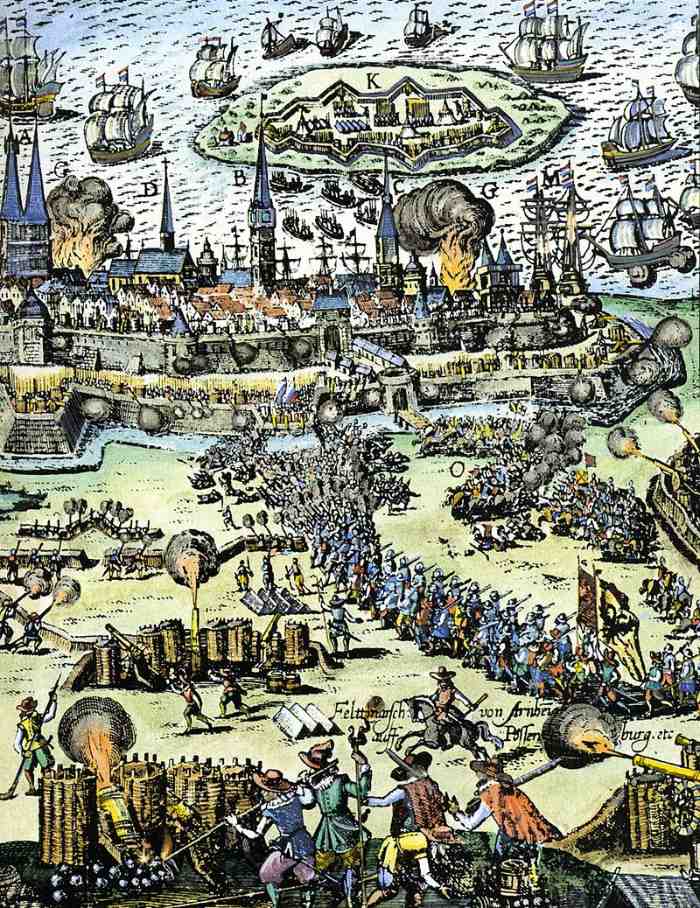
Following the Defenestration of Prague in 1618, Europe was plunged into the Thirty Years’ War. The Duke of Friedland, Albrecht Wallenstein, the supreme commander of the armies of the Holy Roman Empire, created an army of 50,000 men in 1623. After some notable actions, he began the siege of the Hanseatic city of Stralsund, a German city in Mecklenburg-Pomerania. Wallenstein will be forced to lift it after eleven weeks due to a lack of reinforcements.
May 22, 1629: Signing of the Treaty of Lübeck
The Treaty of Lübeck was signed in the city of the same name, located in northern Germany, on May 22, 1629. The parties involved were the Holy Roman Emperor Ferdinand II and the King of Denmark, Christian IV. The Peace of Lübeck followed the invasion of Danish lands by Catholic armies.
According to the terms of the peace, Denmark was compelled to refrain from interfering in the wars of the Holy Roman Empire; prisoners from each side were to be released; and both parties also waived the damages caused by the conflict.
September 25, 1629: Signing of the Treaty of Altmark
The Treaty of Altmark was signed following the defeat of the Swedes against Imperial and Polish-Lithuanian forces at Honigfelde, near Stuhm, where Gustavus Adolphus narrowly escaped capture. The truce was signed for six years under the diplomatic influence of Richelieu.
The Swedes now occupied the entire Baltic coastline. On September 25, 1629, Poland ceded several ports in East Prussia, including Königsberg, and the customs revenues of Danzig to the Livonian region along the Dvina. In exchange, Sweden returned the Duchy of Prussia, excluding the coastal territory.
July 6, 1630: Sweden Enters the Thirty Years’ War
In the midst of the Thirty Years’ War, King Gustavus Adolphus of Sweden negotiated the Treaty of Barwald with France, securing diplomatic and military support in the Baltic region. After several victorious battles against Poland and the Baltic provinces, he landed in Pomerania on July 6, 1630, and deployed his army, the Hakkapélites. He consolidated his positions for almost a year and achieved another victory against the Catholic League’s army, notably at the Battle of Breitenfeld in 1631. His army advanced to the Danube.
November 1630: Beginning of the Siege of Magdeburg
The Holy Roman Empire’s army began the Siege of Magdeburg, the capital of Saxony-Anhalt. This Protestant city was a key player in the Hanseatic League, dominating European trade at the time. Despite its strong fortifications, Magdeburg resisted Catholic forces until the arrival of King Gustavus Adolphus of Sweden, who had been achieving military victories since entering the conflict.
Nevertheless, the city fell in 1631 to the Imperial army, resulting in the massacre of its inhabitants and the complete destruction of the city, an event so brutal that the term “Magdeburgization (Sack of Magdeburg)” became synonymous with total destruction.
December 1, 1630: George I Rákóczi Becomes Voivode of Transylvania
George I Rákóczi, son of Sigismund II Rákóczi, became the Prince of Transylvania, known as “voivode,” on December 1, 1630. Although the throne was supposed to go to his brother Stephen III Bethlen, the support of Catherine of Brandenburg, a powerful woman in the nobility, worked in George’s favor. He married Zsuzsanna Lorántffy, who bore him two sons to succeed him.
During the Thirty Years’ War, the voivode sided with the Protestants, fighting alongside France and Sweden against the Holy Roman Empire. He preserved religious freedom in western Hungary and maintained Transylvania’s independence.
January 23, 1631: Signing of the Treaty of Barwald between France and Sweden
In 1631, King Louis XIII of France decided to support King Gustave Adolphe II of Sweden in his struggle against the Holy Roman Empire. This marked France’s entry into the Thirty Years’ War against the Habsburgs. On January 23, the two sovereigns signed the Treaty of Barwald, establishing a political, military, and commercial alliance.
Cardinal Richelieu was able to equip the rapidly expanding royal navy because of the materials the Swedes provided. Sweden also committed to leading an army of 30,000 soldiers and 6,000 knights in Germany. In return, France incurred a debt of 1.5 million livres tournois per year to Sweden. This treaty lasted until the restoration of peace.
April 6, 1631: End of the War of the Mantuan Succession—Treaty of Cherasco
The War of the Mantuan Succession, a peripheral conflict of the Thirty Years’ War, pitted the French against the Habsburgs over the possession of Mantua after the extinction of the Gonzaga line and the vacancy of the duchy. After several battles, the conflicts of the Thirty Years’ War forced the belligerents to focus on matters other than Mantua. Pope Urban VIII intervened and sent a mediator, Jules Mazarin, who later became Cardinal Mazarin.
The Treaty of Cherasco was signed on April 6, 1631. The disputed territory was divided between the opposing parties, and France received a strategically important fortress, Pinerolo, providing access to the plain of the Italian river Po.
September 17, 1631: Protestant Victory at the Battle of Breitenfeld
The Battle of Breitenfeld marked the first significant victory for the Protestants under Gustavus Adolphus of Sweden against the Catholics under General Tilly during the Thirty Years’ War. The two armies clashed on September 17, 1631, near Breitenfeld, north of Leipzig. Despite seven charges by the light cavalry of Count Pappenheim, the squadrons of cavalry interspersed with musket-armed infantry under Gustavus Adolphus eventually routed the Catholic army.
This victory led other Protestant states to join Sweden, demonstrating that the well-equipped and pike-heavy Imperial armies could be defeated by mobile troops and the power of firearms.
April 19, 1632: Death of King Sigismund III Vasa of Poland and Sweden
After the death of Stephen Bathory I, Sigismund III of the Vasa dynasty was elected King of Poland and Grand Duke of Lithuania in 1587, despite the claims of Maximilian III of Austria. Sigismund was also to succeed his father on the throne of Sweden and was crowned in Uppsala in 1594, with the condition that the country could remain Protestant.
He then returned to Poland and sought an alliance with the Habsburgs to lead the Central European powers in a war against the Turks. During his absence, his uncle worked to gain power in Sweden, and after a short succession war, Sigismund had to relinquish the throne and leave Sweden, paving the way for several Polish-Swedish wars.
From 1605 to 1618, he led his army into Russia, gaining several territories in the Smolensk region. When the Thirty Years’ War broke out in 1618, he sided with the Catholics. His son, Ladislaus IV, succeeded him in this struggle.
April 30, 1632: Death of General Tilly, Commander-in-Chief of the Holy Roman Empire’s Armies
Jean t’Serclaes, Count of Tilly, served as the Commander-in-Chief of the armies of the Catholic League and the Holy Roman Empire during the Thirty Years’ War. Born in 1559, he was raised in the Catholic faith and by the Jesuits.
He won significant battles, such as the Battle of Stadtlohn against Christian of Brunswick in 1623 and the Battle of Lutter in 1626 against Christian IV of Denmark, who later signed the Peace of Lübeck. In August 1630, he was appointed Commander-in-Chief after the dismissal of Wallenstein.
He was responsible for the sack and near-destruction of Magdeburg, which he besieged in 1631 against Gustavus Adolphus of Sweden and later suffered defeat against the Swedes at Breitenfeld. While attempting to oppose their advance towards Munich, he was wounded at the Battle of Rain am Lech and died on April 30, 1632.
November 6, 1632: Death of Gustavus Adolphus of Sweden at the Battle of Lützen
Near Leipzig in Saxony-Anhalt, Generalissimo Wallenstein’s army of the Holy Roman Empire faced Protestant armies under Gustavus Adolphus, King of Sweden, during the Thirty Years’ War. The Battle of Lützen would be one of the most significant, as the King of Sweden met his death. Upon learning of the approach of the Swedes, Wallenstein sent a message to General Pappenheim, asking him to join with his troops.
Pappenheim’s forces immediately departed, but they were 40 kilometers away from Wallenstein. The next day, the battle favored the Swedes, but Pappenheim arrived with reinforcements of 3,000 cavalry. He succumbed during the first charge, and shortly after noon, King Gustavus Adolphus was also fatally wounded during another charge. However, this did not prevent the Protestants from continuing and winning the battle, ultimately securing the protection of Saxony from the Emperor.
November 6, 1632: Accession to the Throne of Queen Christina of Sweden
King Gustavus Adolphus of Sweden was mortally wounded at the Battle of Lützen on November 16, 1632. Foresighted and having only one daughter, he had ensured that she could succeed him by abolishing the exclusively male succession in 1627.
Christina of Sweden, barely 6 years old, thus ascended to the throne. She remained under the tutelage of Chancellor Axel Oxenstierna until her majority in 1644. Queen Christina then dismissed her guardian and advocated for lasting peace after the Treaty of Westphalia in 1648. This treaty, which granted Sweden numerous territories, made Sweden the leading power in the Nordic region.
She abdicated in 1654 and secretly converted to Catholicism before being welcomed in Italy, where Pope Alexander VII gave her communion.
November 8, 1632: Election of Ladislaus IV Vasa to the Throne of Poland and the Beginning of His Reign
Ladislaus IV, the only son of Sigismund III of Poland and a member of the Vasa dynasty, was elected King of Poland by the Diet, the assembly of Polish nobles, on November 8, 1632. At 15 years old, while his father fought the Russian army and took Moscow, Ladislaus was proclaimed Tsar by a small faction of the boyars, but the Russians rejected this nomination and revolted against the 3,000 Polish soldiers stationed at the Kremlin.
Although defeated, Ladislaus claimed the title of Tsar of Russia until 1634. He also fought against the Ottomans in 1621 and then against the Swedes from 1626 to 1629, establishing himself as a defender of Catholicism. He even dreamed of leading a crusade to regain the Balkans, then under Ottoman rule.
On November 8, 1632, the Diet elected Ladislaus as King of Poland. He proclaimed Poland neutral during the Thirty Years’ War, although he later married Archduchess Cecilia Renata of the Habsburgs.
December 1, 1633: Death of the Spanish Infanta, Archduchess of Austria, and Governor of the Spanish Netherlands
Born in 1566, Isabella Clara Eugenia of Austria, from the Habsburg dynasty, was the daughter of King Philip II of Spain and the granddaughter of King Henry II of France. She could claim the throne of Spain, as well as that of France and the Duchy of Brittany. Faced with opposition, she received the throne of the Netherlands in dowry through her marriage to Albert of Austria, the son of Emperor Maximilian II.
Her court included renowned artists like Rubens and Brueghel. The couple managed to establish peace between the Protestant Netherlands and Catholic Spain, fostering economic prosperity. Albert died in 1621, and Isabella died on December 1, 1633, after ensuring a period of calm. In 1648, the Treaty of Westphalia marked the end of the Thirty Years’ War, and the Netherlands would be definitively separated from the Spanish crown.
1634: Beginning of the Ten Years’ War in Franche-Comté
While the Thirty Years’ War raged in Europe, the territory of Franche-Comté was peaceful and under Spanish rule. King Philip II of Spain died in 1598, leaving the Netherlands and Franche-Comté to his daughter, Infanta Isabella of Spain, and her husband Albert of Austria. Isabella renewed the neutrality pact concerning Franche-Comté with France in 1611, a pact to be respected until at least 1640.
After Isabella and her husband passed away, Franche-Comté’s fate fell into the hands of Philip IV of Spain. As the Holy Roman Empire achieved several victories, Cardinal Richelieu pointed out to King Louis XIII of France that Burgundy and Franche-Comté would be easy to conquer. Concerned about the Catholic advance, Louis XIII broke the neutrality pact in 1634 and sent an army of 25,000 led by the Prince of Condé.
The Ten Years’ War had begun and would only end in 1644 after France ceased hostilities in exchange for 40,000 ecus.
February 25, 1634: Assassination of General Wallenstein After Being Accused by Emperor Ferdinand II
During the Thirty Years’ War, Commander Wallenstein assembled a large army of nearly 50,000 men to fight on behalf of Emperor Ferdinand II. After some dazzling victories, he retired to Bohemia, near Pilsen, to reflect on his actions with astrologers and doctors. It is acknowledged that he negotiated with enemy powers to be placed on the throne of Bohemia, thereby threatening the emperor’s succession by his son Ferdinand III.
Wallenstein believed that his army would not dare to turn against him. However, an edict accusing him of high treason was published in Prague on February 18, 1634, and Wallenstein fled to Eger to seek protection from the Swedish army stationed there. A regiment of Irish and Scottish dragoons was dispatched, assassinating him on the night of February 25. Wallenstein was replaced by his lieutenants, Piccolomini and Gallas. He remains the true founder of the Austrian army and the unprecedented war tax that facilitated its creation.
5 September 1634: Battle of Nördlingen and Victory of Emperor Ferdinand III of Hungary over the Swedes and Lutherans
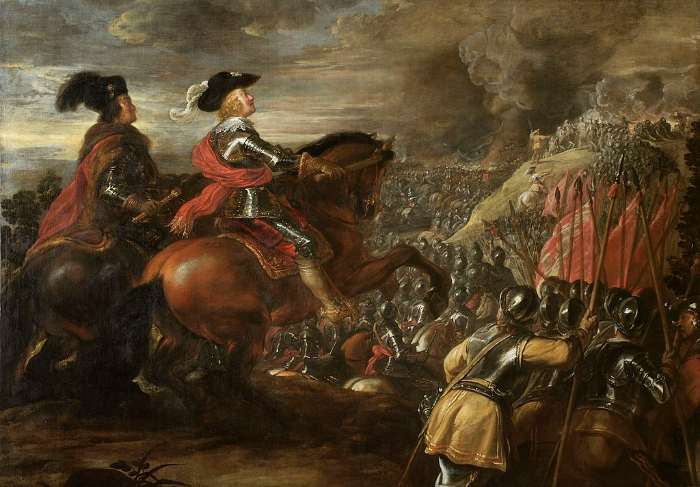
The Battle of Lützen on April 19, 1632, marked the victorious death of the Swedish king, Gustavus Adolphus. Despite this Protestant triumph, securing Saxony-Anhalt, the Imperial Spanish army occupied and threatened to advance into Saxony by capturing Regensburg. In response, the Protestants under Gustaf Horn planned a night attack to retake the city.
However, poor troop management resulted in artillery and supply wagons being ahead of the infantry, allowing the enemy forces to prepare. During the Battle of Nördlingen on the night of September 5 to 6, 1634, the Protestant army suffered a significant loss of 12,000 to 14,000 men, and Gustaf Horn was captured.
This marked the first defeat for the Swedes in the Thirty Years’ War, prompting France to openly enter the war against the Holy Roman Empire.
11 October 1634: Schleswig-Holstein Flood in the North Sea caused by the Burchardi Storm
Amid the aftermath of a 1603 plague epidemic and the ongoing Thirty Years’ War, the Schleswig-Holstein region in present-day Germany faced challenges. The North Sea had been turbulent for years, with icebergs damaging coastal dikes in 1625. On the night of October 11 to 12, 1634, the Burchardi Storm generated a storm surge that engulfed a significant part of Strand Island.
This storm surge, or mandränke, caused the deaths of 8,000 to 15,000 people, including two-thirds of Strand’s population. The disappearance of Strand gave rise to new islands: Nordstrand, Pellworm, Halligen Südfall, and Nordstrandischmoor.
16 May 1635: France enters the Thirty Years’ War
France, 17 years into the Thirty Years’ War, declared war on Spain, which had intervened to support the Catholic forces in the Empire. Fearing encirclement by the Catholic Habsburg alliance, France allies with the Protestant armies of the North.
30 May 1635: Signing of the Peace of Prague
The Peace of Prague, signed on May 30, 1635, between Emperor Ferdinand II of the Holy Roman Empire and Elector John George I of Saxony, representing Protestant states in Saxony-Anhalt, ended the civil war aspect of the Thirty Years’ War. The treaty recognized the electoral dignity of Bavaria, and John George I permanently gained Lusatia, a territory northeast of Germany. However, fighting continued with the Swedes and then the French until the Peace of Westphalia in 1648.
22 June 1636: Battle of Tornavento and victory of the Franco-Savoyards over the Spanish
In 1636, during the Thirty Years’ War, Cardinal Richelieu convinced Duke Victor Amadeus I of Savoy to launch an offensive on the Spanish Duchy of Milan. A French army crosses the Ticino River but encounters the Spanish army at Tornavento before their Savoyard allies arrive. On June 22, the Spanish attack and the Savoyard army arrived just in time to reverse the outcome.
The Franco-Savoyard army stays for a few days to pillage surrounding villages but ultimately withdraws from Milanese territory. This invasion of Lombardy marks a failure.
2 July 1636: Philip IV of Spain sends his generals to besiege La Capelle in Picardy
Count Jean de Werth, notable in the Battle of Nördlingen, becomes a general in the Holy Roman Empire’s army alongside General Piccolomini. In 1635 and 1636, they were sent to Lorraine, Picardy, and Luxembourg, pillaging the Lower Meuse in July 1636. They besiege the town of La Capelle on July 2, 1636. The invasion sparks a nascent French patriotic spirit, leading to an army of 50,000 that forces Jean de Werth and Piccolomini to retreat.
4 October 1636: Battle of Wittstock and Swedish victory over the Emperor
The Thirty Years’ War pits the Holy Roman Empire against the Protestant Swedes and their allies for control of northern Germany. In 1636, both armies were positioned on either side of the Elbe River. Swedish General Johan Banér crosses his army and meets the Imperial forces near the Scharfenberg hills south of Wittstock.
The Saxon troops are less experienced, and the Swedish artillery is superior. Johan Banér’s army wins the battle, but it has no strategic consequences as Brandenburg refuses to join the Swedes. As a new Imperial army under the command of Matthias Gallas forces the Swedes to retreat to their previous position, they make an unsuccessful attempt to siege Leipzig.
6 October 1636: Victory at Szalonta of Transylvanian Prince George I Rákóczi over the Turks
George I Rákóczi, Prince of Transylvania from 1630 to 1648, ascended to the throne with the support of Catherine of Brandenburg. His first military victory was at Szalonta, where he defeated the Turks on October 6, 1636. George I Rákóczi later intervened in the Thirty Years’ War on the side of the Protestants.
15 February 1637: Death of Holy Roman Emperor Ferdinand II of Habsburg
Born in 1578, Ferdinand II of Habsburg was raised by Jesuits as a devout Catholic and opponent of Protestantism. His actions provoked the Thirty Years’ War by angering Protestant nobles in Bohemia. He, along with General Tilly, defeated the Protestant army at the Battle of White Mountain in 1620, making Bohemia a territory of the empire.
The Swedes, led by King Gustavus Adolphus II, entered the conflict and defeated them at the Battle of Breitenfeld. Ferdinand II’s reign was consumed by the war, resulting in the demographic and economic ruin of Germany. His son, Ferdinand III of Habsburg, succeeded him upon his death on February 15, 1637.
15 February 1637: Beginning of the Reign of Holy Roman Emperor Ferdinand III
The son of Emperor Ferdinand II and Marie Anne of Bavaria, Ferdinand III of Habsburg, was born on July 13, 1608. He became King of Hungary in 1625 and King of Bohemia in 1627 but had to wait until Ferdinand II’s death in 1637 to become the “King of the Romans,” i.e., Emperor of the Holy Roman Empire.
During the Thirty Years’ War, he gained fame for his victory over the Swedish Protestants at the Battle of Nördlingen. However, in the following years, he couldn’t fight simultaneously against the Swedes and their French allies. In 1648, he was compelled to sign the Peace of Westphalia, Münster, and Osnabrück, marking the actual end of the Holy Roman Empire’s dominance in Europe.
28 September 1637: Battle of Leucate and French Victory Over the Spanish
Situated south of Narbonne, the Leucate castle served as a stronghold and an observation point for five centuries. During the Thirty Years’ War, the French and Spanish Imperial armies faced off at the castle. The Spanish besieged it, but on September 28, 1637, the French achieved victory, forcing the Spanish to retreat across the border. Following the signing of the Treaty of the Pyrenees in 1659, Louis XIV later demolished the castle.
7 October 1637: Death of Victor Amadeus I, Duke of Savoy and Prince of Piedmont
Born in 1587, Victor Amadeus I was the Duke of Savoy and Prince of Piedmont. He married Christine of France in 1619, and they had seven children. Victor Amadeus faced defeat early in his rule, losing the fortress of Pinerolo and part of Montferrat. Convinced of his royal status, he adopted the title of King of Cyprus, a historical claim of his ancestors. He finally achieved victory at the Battles of Tornavento in 1636 and Mombaldone in 1637 but died a few days later in Vercelli on October 7, 1637.
1 December 1640: Portugal Regains Its Independence
The Portuguese nobility revolted against Spanish rule, restoring the country’s independence. They placed one of their own, John of Braganza, on the throne, who took the name John IV. This followed the death of King Sebastian of Portugal in 1578 and the ascension of Philip II of Habsburg to the Spanish throne.
14 September 1641: The Treaty of Péronne
The Treaty of Péronne, signed on September 14, 1641, between King Louis XIII of France and Honoré II Grimaldi of Monaco, ended the Spanish protectorate and reintegrated the Principality of Monaco into the French sphere. In exchange for the return of Monaco, Louis XIII confiscated Honoré II’s assets in Spain.
9 September 1642: Louis XIII Captures Perpignan from the Spanish
Louis XIII’s army heads to Roussillon to reclaim the region during the Reaper’s War. To retake the Spanish-held city of Perpignan, French forces besieged the area. The siege, from November 4, 1641, to September 9, 1642, ended with the governor’s decision to surrender, as only 500 survivors remained in the city. Louis XIII passed away a few months later.
19 May 1643: Grand Condé Victorious at Rocroi
The French, under the command of the Duke of Enghien, later known as Grand Condé, defeated the Spanish at Rocroi in the Ardennes in a resounding victory during the Thirty Years’ War. The 22-year-old duke displayed military genius, marking France’s return to the international stage after a century of defeats and civil wars.
31 July 1644: Reconquest of Lerida
In 1642, nearly all Catalan cities were under French control. King Philip IV of Spain aimed to reclaim Lleida and launched an offensive on the adjacent plain. However, the French organized and assembled a significant army to oppose him. The Spanish suffered heavy losses and had to wait two years before reconquering Lleida.
18 December 1644: Majority of Queen Christina of Sweden
Queen Christina of Sweden, ascending to the throne due to her father securing the abolition of male exclusivity, took power at the age of 18 on December 18, 1644. She ousted Chancellor Axel Oxenstierna to promote peace and halt conflicts with Denmark.
6 March 1645: Battle of Jankau
On March 6, 1645, the Swedes, en route to Prague, prevailed over Imperial forces in southern Bohemia at the Battle of Jankau. Considered one of the deadliest battles of the Thirty Years’ War, the Imperial cavalry was annihilated, allowing the victorious Swedes to subsequently attack Vienna, leading to a second battle in August of the same year.
3 August 1645: Battle of Nördlingen
The Battle of Nördlingen, part of the Thirty Years’ War, pitted the Holy Roman Empire’s troops against the French. The General Von Mercy-led opposition confronted the Duke of Enghien-led French army. Both sides suffered significant losses, but the death of General Von Mercy concluded the battle, with his troops retreating to the village, resulting in a French victory.
13 August 1645: The Treaty of Brömsebro
The Peace of Brömsebro concluded on August 13, 1645, ending a conflict (the Torstenson War) within the Thirty Years’ War involving Sweden, Denmark, and Norway. Besides concluding the conflict, the treaty included the cancellation of toll taxes for Swedish ships and territorial concessions by Denmark and Norway.
May 1646: First Siege of Lleida
In May 1646, the French, led by Henri de Lorraine-Harcourt, initiated the siege of Lleida, a Spanish city. Only two years had passed since the Spanish had regained the city, and they were determined to defend it vigorously. The siege lasted approximately six months, culminating in the French forces retreating to the nearby town of Balaguer without baggage or artillery.
7 September 1646: Siege of Dunkirk
When Louis II de Bourbon-Condé, Duke of Enghien, took sole command of the Flanders army, he envisioned a brilliant action: the siege of Dunkirk, which the Spanish held for over eighty years. His army, reinforced by Poles and Ukrainians on land and the Dutch at sea, besieged Dunkirk. As the Spanish failed to gain English support, the gates of Dunkirk opened on October 11, 1646.
17 June 1647: End of the Siege of Lleida
On May 12, 1647, the siege of Lleida commenced with the arrival of Louis II de Bourbon-Condé, known as Le Grand Condé. Mazarin, seeking to distance him from France, promised him victory where Henri de Lorraine-Harcourt had failed the previous year: Lleida. Le Grand Condé eagerly accepted the challenge. Immense losses and desertions led to the siege being lifted on June 17, 1647.
20 August 1648: Last Battle of the Thirty Years’ War
On August 20, 1648, the Battle of Lens took place, named after the capture of the city of Lens by Archduke Leopold Wilhelm of Habsburg on August 17, 1648. Disappointed by the defeat at the Siege of Lleida, Grand Condé motivated his troops with the motto, “We must conquer or die.” The result was a victory against the Spanish.
8 September 1648: The Independence of the United Provinces is Recognized in the Treaty of Münster
As part of the signing of the Peace of Westphalia treaties, concluding the Thirty Years’ War, the independence of the United Provinces was acknowledged by Spain in the Treaty of Münster. The conflicts between the United Provinces and Spain, which had been ongoing since the revolt of William I of Nassau against the Duke of Alba, have come to an end.
24 October 1648: Publication of the Peace of Westphalia Treaties
Both Catholics and Protestants signed the Peace of Westphalia treaties. The Catholics in Münster on September 8 and the Protestants in Osnabrück on August 6. This marks the conclusion of the Thirty Years’ War. France gained a portion of Alsace, Sweden and Germany acquired territories, while the Netherlands and Switzerland achieved their independence.
Thirty Years’ War at a Glance
What Was the Thirty Years’ War?
The Thirty Years’ War was a protracted conflict fought primarily in Europe from 1618 to 1648. It was primarily a religious war involving Catholic and Protestant states and resulted in significant political and territorial changes.
What Were the Main Causes of the Thirty Years’ War?
The main causes of the war included religious tensions between Catholic and Protestant states, conflicts over political power and territorial control, and a struggle for dominance among European powers.
Which Countries Were Involved in the Thirty Years’ War?
The war involved various European powers, including the Holy Roman Empire, Spain, France, Sweden, Denmark, and the Netherlands. Many smaller states and principalities also played a role in the conflict.
How Did the Protestant Reformation Contribute to the War?
The Protestant Reformation, which had begun in the early 16th century, created deep religious divisions in Europe. Conflicts between Catholic and Protestant states intensified, leading to tensions and sparking the outbreak of the war.
What Was the Significance of the Peace of Westphalia?
The Peace of Westphalia, signed in 1648, marked the end of the Thirty Years’ War. It established a new framework for European diplomacy, recognized the independence and sovereignty of individual states, and granted religious freedom to Protestants.
Bibliography:
- Groenveld, Simon (2009). Unie – Bestand – Vrede. Drie fundamentele wetten van de Republiek der Verenigde Nederlanden.
- Bireley, Robert (1976). “The Peace of Prague (1635) and the Counterreformation in Germany”. The Journal of Modern History. 48 (1): 31–69. doi:10.1086/241519. S2CID 143376778.
- Outram, Quentin (2001). “The Socio-Economic Relations of Warfare and the Military Mortality Crises of the Thirty Years’ War” (PDF). Medical History. 45 (2): 151–184. doi:10.1017/S0025727300067703. PMC 1044352. PMID 11373858.
- Outram, Quentin (2002). “The Demographic impact of early modern warfare”. Social Science History. 26 (2): 245–272. doi:10.1215/01455532-26-2-245.
- Whaley, Joachim (24 November 2011), “Germany and the Holy Roman Empire in 1500”,



